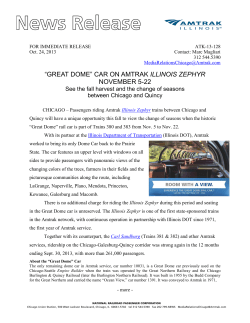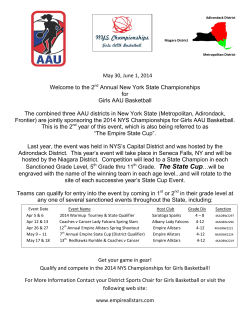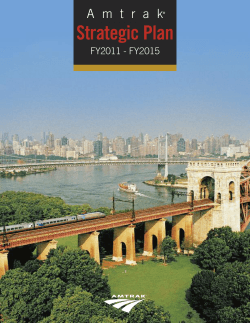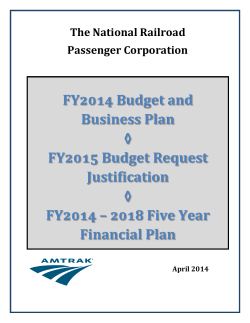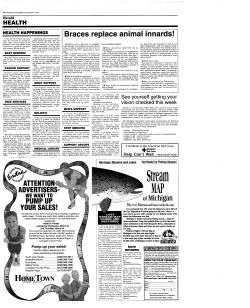
a d i r o n d a c k MonTréal wEsTporT
adirondack RO U T E G U ID E Montréal • westport • saratoga springs • new york We hope you enjoy reading this guide and learning about points of interest along our route. It is written starting from the southern terminus of the train in New York City and proceeds to points north, ending in Montréal, Québec, Canada. If you boarded in Montréal, just read the guide in reverse. AMTRAK STATIONS are shown in all capital letters, as opposed to upper and lower case for towns and geographical areas through which the train travels but does not stop. The Amtrak System Timetable or the Adirondack panel card should be consulted for actual station times. While all service presented in this guide was accurate at the time of publication, routes and services are subject to change. Please contact Amtrak at 1-800-USA-RAIL, visit Amtrak.com or call your travel agent for the most current information. Depart New York City and travel back in time as you pass dramatic geological features with origins 200 million years old. Feature attractions between the bombast of Broadway and the charm of Old Montréal include the magnificent Palisades; the Adirondack Mountains; the ruins of worldfamous Bannerman’s Castle; the iconic Academy at West Point; the gateway to Catskill Mountain resorts; and the Hudson River Valley that inspired an entire artistic genre with its visual jewel, Lake Champlain. Living history from your train window conjures images of Benedict Arnold delaying the British Fleet at the south end of the lake to prevent the fall of Fort Ticonderoga – an overlooked feat for which he is less remembered than for his infamous reputation as a turncoat. From your lookout for reputed lake monster “Champ” to the visual combination of history and modernity that defines Montréal, the Adirondack serves up a kaleidoscope of scenes upon which you will reflect for some time to come. So relax and enjoy this unique 381-mile view of eastern New York and Québec from your picture window! [The Adirondack is the modern descendent of a service that originally carried the colors of the Delaware and Hudson Railway (D&H), which had its beginnings in the early 1820s as a canal company organized to transport coal from Pennsylvania to New York City. Now defunct, it once called itself “America’s oldest continually operating transportation company.” After Amtrak took over passenger operations in 1971, D&H inaugurated, in 1974, its New York-Montréal service under a funding agreement with Amtrak and the State of New York. Using rebuilt ALCO locomotives and refurbished 1950s passenger cars, this “streamliner” revival delighted fans in the Empire State. After Amtrak replaced its equipment with turbine-powered trainsets, the original locomotives were sold to an operator in Mexico; one of them currently resides in a museum there.] wElcoME aBoard Relax and enjoy the comfort of train travel while you take in some of the most dramatic geological and historical scenery along New York’s eastern border – including its magnificent jewel, Lake Champlain. From Revolutionary War battle scenes to mountain resorts to the cosmopolitan French-speaking city of Montréal, the Adirondack serves up a variety of visual delights framed by your train window. All the while, you enjoy superb service and amenities. We are happy to have you onboard today and want to ensure you trip is everything you want it to be. If there is anything that can be done to make your trip more enjoyable, please do not hesitate to ask any Amtrak employee. The Train Staff The staff of the Adirondack is here to make your trip a special and enjoyable experience. Conductor is responsible for the entire On-Board Services staff as well as ticket collection, the safety of passengers and the safe operation of the train. Café Car Attendant is responsible for the operation of the Café car. ACCOMMODATIONS Coach seating provides a wide reclining seat with leg rest, folding tray table and overhead reading light. Free pillows are also available. Amfleet Dinette is the perfect location for scenic viewing and lighter fare. Large panoramic windows provide the ideal vantage point for sightseeing and making new friends. The Café offers sandwiches, snacks and beverages. HOST RAILROADS are the freight and commuter railroads that Amtrak contracts with to operate Amtrak passenger trains. The Adirondack trains operate between New York and Yonkers on Amtrak, between Yonkers and Poughkeepsie on Metro North Railroad, between Poughkeepsie and Schenectady on CSX Transportation, between Schenectady and Rouses Point on Canadian Pacific, and between Rouses Point and Montréal on Canadian National lines. Information contained in this route guide as well as described amenities and features are subject to change without notice. While gratuities are not required for services provided, it is an appreciated way to convey to an employee that he or she has made your trip more enjoyable. Lake Champlain Adirondack Route Guide 2 Montréal ST. LAMBERT, QC Cantic Lake Champlain PLATTSBURGH, NY PORT KENT, NY Lake Placid WESTPORT, NY PORT HENRY, NY TICONDEROGA, NY Ft. Ticonderoga WHITEHALL, NY GLENS FALLS, NY FORT EDWARD, NY SARATOGA SPRINGS, NY SCHENECTADY, NY ALBANY-RENSSELAER, NY Rhinecliff-Kingston HUDSON, NY Ft. Bridge RHINECLIFF, NY Hudson River POUGHKEEPSIE, NY Bannerman’s Castle Catskills CROTON-HARMON, NY The Tappan-Zee Bridge Irvington YONKERS, NY Harlem River NEW YORK is America’s most populous city. So famous are its districts that Wall Street, Broadway and Madison Avenue are universally recognized shorthand for the industries located there. It is a global city, with worldwide influence over commerce, finance, culture and entertainment and the arts. It is also an important center for international affairs, hosting the United Nations headquarters. Unique among U.S. cities for its extensive use of mass transit, and the density and diversity of its population, its reputation as a city that never sleeps is due to its 24-hour subways and the constant bustling of traffic and pedestrians. Birthplace of numerous cultural movements, its metropolitan population surpassed 10 million in the early 1930s, making it the first “megacity” in human history. Harlem River The Harlem flows eight miles between the East River and the Hudson River, separating the boroughs of Manhattan and the Bronx. The Harlem has served as a traditional rowing course for New York, used by university crews from Columbia, Fordham, New York and Manhattan College. Columbia’s rowers have assisted New York Police Department investigations by sighting bodies in the water, as has been depicted in the TV series Law & Order. We cross the river at a point called Spuyten Duyvil -- Dutch for “spitting devil” -- that describes the tricky currents here where the Harlem River joins the Hudson River. YONKERS is spread over hills rising from near sea level on the eastern bank of the Hudson River. Primarily a commuter city for workers into Manhattan, it is possessed of an excellent transportation infrastructure. Its attractions include Yonkers Raceway, the Philipse Manor Hall museum and archive, and many large shopping areas along Central Park Avenue. Its name derives from the Dutch word for “young gentleman,” Jonker; this is how the recipient of the original land grant, Colen Donck, was known locally in 1645. In 1853, the Otis Elevator Company built the first such factory here. Today, a Kawasaki railcar assembly plant occupies its former facility, supplying several U.S. state and municipal systems with transit vehicles, including New York City. The first U.S. golf course was founded here in 1888. Steven Tyler of the rock band Aerosmith is a notable resident. Hastings-on-Hudson was once a center of stone quarrying. Huge quantities of dolomite marble were used to produce the paving blocks found extensively in New York City’s Central Park and in other cities. The town is now an upscale community, the current and former home of numerous high achievers in diverse fields of endeavor. Irvington takes is name from the author Washington Irving, creator of Rip Van Winkle, Ichabod Crane and The Legend of Sleepy Hollow. Nearby “Sunnyside” was his home and can be seen from the train near the station. The town’s cool summer breezes and attractive setting along the riverbank have attracted wealthy residents of New York City since the 1850s. It is today a community of the well-heeled which includes Today Show co-host Meredith Vieira, actress Debra Winger, and Reverend Sun Myung Moon, head of the Unification Church. Its controversial mayoral election of 2005 resulted in the declaration of a winner by drawing lots after a tie vote could not be broken. CROTON-HARMON, or Croton-on-Hudson, is the northern limit of the Hudson line railroad’s electrification and a transfer point between local and express service. Historically, it thrived as a maintenance point for the former New York Central Railroad and its labor-intensive operations. Trains continuing north or west, including the flagship 20th Century Limited, exchanged their electric locomotives here for a steam or diesel locomotive to continue their journeys. Nearby is General Electric’s John F. Welch Leadership Center, which trains GE executives. Today, there is an ongoing effort to develop the riverfront area for recreational use. Many Croton residents commute into New York City’s Grand Central Terminal some 33 miles south via Metro-North Railroad. New York Adirondack Route Guide 3 Bannerman’s Castle Peekskill was an early American industrial center and the first headquarters of the Continental Army during the Revolutionary War. In 1992, the town was the site of a meteorite landing, recorded on film by 16 witnesses, which punched through the trunk of a 1980 Chevrolet Malibu. That car was later displayed on a world tour. The 1980s fictional TV sitcom The Facts of Life was set in Peekskill. West Point Academy, marked by stone battlements on the western (opposite) shore of the river, is a U.S. Army post and service academy. Its first commander, Benedict Arnold, famously committed treason when he attempted to sell the fort to the British. West Point trains more Army officers than any other single institution. Occupying over 16,000 acres, it is one of the largest school campuses in the world. In addition to the typical academic buildings and sports facilities, it includes a ski slope and artillery range. First occupied in 1778, it is the oldest continuously manned military post in the U.S. Bobby Knight, the winningest men’s basketball coach in NCAA history, began his head coaching career at Army in the 1960s. Notable alumni include Presidents Grant and Eisenhower, Confederate President Jefferson Davis, and Generals Robert E. Lee, John J. Pershing, Omar Bradley and Douglas McArthur. Pollepel Island is the site of Bannerman’s Castle, an abandoned military supply warehouse. Francis Bannerman purchased the island in 1900 to use as a storage site for his growing business. Construction of the castle began in 1901; most of the building was devoted to stores of army surplus. Today, the castle is property of the New York State Office of Parks, Recreation and Historic Preservation. The island itself, mostly rock, covers 6.5 acres; its name is derived from the Dutch word for “wooden spoon.” Beacon received its name from the signal fires that were set atop nearby Beacon Mountain to warn of approaching British troops during the Revolutionary War. During the 1800s, the town was known as the “Hat Making Capital of the U.S.” with some 50 factories devoted to their manufacture. Its artistic and commercial rebirth came with the opening of one of the world’s largest contemporary art museums, a waterfront hotel and conference center. Across the river is its larger sister city, Newburgh. POUGHKEEPSIE was home to the Smith Brothers’ famous cough drops until 1972. The area’s natural beauty and proximity to New York City prompted wealthy families like the Astors and Vanderbilts to build palatial weekend homes nearby. The city was an early center for whale rendering, and industry flourished through shipping, hatteries and breweries – some owned by Matthew Vassar, founder of Vassar College here. Samuel Morse, inventor of the telegraph and Morse code, made this his home for 25 years. RHINECLIFF-KINGSTON The hamlet of Rhinecliff in the town of Rhinebeck encompasses the largest district of National Historic Landmark designation in the country. Kingston’s downtown area, known as “the Rondout,” is considered one of the nation’s best places for artists. It was also the first capital of New York between 1777 and 1797. Kingston once shaped and shipped most of the “bluestone” used to build the sidewalks of New York City. The Amtrak station here was built by the former New York Central Railroad in the early 20th century and hosts several Amtrak trains serving nearby Poughkeepsie as well as Montreal, Toronto, Niagara Falls and New York City. Kingston may be accessed by taxicab from the station. Catskill across the Hudson River was once a stopover for vacationers on their way to the Catskill Mountain resorts. The area was purchased from natives in 1678 and the town was established in 1788. Former undisputed world heavyweight boxing champion “Iron” Mike Tyson once trained at the Catskill gym owned by the legendary trainer Cus D’Amato, who took the young fighter out of reform school and welcomed him into his family. Across the river on the right is the Saugerties Lighthouse, decommissioned in 1954 as automation made light keepers obsolete. It is today a unique bed and breakfast. HUDSON is named for the adjacent river and its discoverer and explorer, Henry Hudson. Its 7,000 residents include some 500 inmates at the Hudson Correctional Facility. Famous natives of Hudson include General William Jenkins Worth, whose leading role in the U.S. victory over Mexico in the Mexican-American War made permanent the liberation of Texas. The city of Fort Worth is named for him. Today, Hudson’s main thoroughfare, Warren Street, hosts a lively antiques market of almost seventy shops. Several television shows have been filmed here, including The Wonder Years. Castleton-on-Hudson is a largely residential suburb of Hudson. It name was derived from Henry Hudson’s experience during exploration of his namesake river, whereupon he encountered a Native American food storehouse so large it was considered a castle. ALBANY-RENSSELAER Albany is the capital of the State of New York. Its capitol building is one of only ten state capitol buildings in the U.S. without a dome. The English acquired the original site from the Dutch in 1664 and named it in honor of James II, Duke of Albany. Adirondack Route Guide 4 It is the fourth oldest city and the second oldest state capital in the U.S. In 1754, Benjamin Franklin presented his “Albany Plan of Union” to the Albany Congress, the first formal proposal to unite the colonies. Although never adopted, it proved to be an important precursor to the U.S. Constitution. In the midtown section, the Empire State Plaza contains the tallest building in the state outside of New York City, the Erastus Corning Tower. The Plaza is modeled on the National Congress complex in Brazil’s capital city, Brasilia. The local economy is based on state government and nanotechnology. Unlike most of the nation, Albany’s “last call for alcohol” in the bars is 4:00 a.m. Albany public schools spend $9,227 per student, well above the U.S. average of $6,068. Famous natives of Albany include Andy Rooney, the humorist and commentator famous for his part on the CBS news program 60 Minutes. The Amtrak station is located in Rensselaer, 1.5 miles from Albany across the Hudson River. The structure dates from 2002, featuring a coffee shop, newsstand and post office. One of the busiest stations in the Amtrak system, it serves northeastern routes outside of the Northeast Corridor “spine.” They include this train, the Adirondack, serving Montreal and New York City; Empire Service between either AlbanyRensselaer or Buffalo and New York City; the Ethan Allen Express serving Rutland Vermont and New York City; and the Maple Leaf serving Toronto and New York City. Here, also, the Boston and New York City branches of the Lake Shore Limited to and from Chicago meet. SCHENECTADY is the ninth largest city in New York State. It became the headquarters of the General Electric Company in 1892 after Thomas Edison had moved his Edison Machine Works here. The company generated the first television broadcasts in the U.S. in Schenectady in 1928. Union College is the oldest planned campus in the country. Former President Jimmy Carter began graduate studies in nuclear physics at Union College in 1953. Schenectady is the former home of the American Locomotive Company, ALCO, which once supplied many major U.S. railroads with motive power. SARATOGA SPRINGS was best known in history for the famous Battle of Saratoga, which took place in the town of Stillwater, some 24 miles to the southeast. The surrender of British General John Burgoyne to American General Horatio Gates in 1777 is cited as the turning point of the Revolutionary War. Saratoga Springs was once famous for Rock Spring, the mineral waters of which were thought to have medicinal value; today, the spa treatments continue at Roosevelt Baths. Since 1863, the town has played host to thoroughbred horse racing at Saratoga Race Course, the oldest continuously-operating track in the U.S. There are several museums and 20 golf courses in the area, along with vibrant night life. Singer Don McLean is said to have composed American Pie in a downtown bar. The Saratoga Performing Arts Center is a stop for touring national recording artists and the summer home of the Philadelphia Orchestra and New York City Ballet. Actor David Hyde Pierce and former NFL coach Bill Parcells are notable Saratogians. FORT EDWARD/GLENS FALLS The Town of Fort Edward is part of the Glens Falls Metropolitan Statistical Area and was originally called Fort Lyman, constructed in 1755 during the French and Indian War. The name was changed the next year to honor King George II’s grandson, Prince Edward. Glens Falls refers to a large waterfall in the Hudson River on the southern border of the city; the falls was the site of several battles during the French and Indian and Revolutionary Wars. The region is a major producer of medical devices. The city also boasts the 300-seat Charles R. Wood Theater, home to the Adirondack Theater Festival; the Glens Falls Symphony Orchestra; three museums; and an exclusive grilled delight dating to 1919 known as the “dirt dog” due to the color of its proprietary meat sauce concoction. Annual festivals are held to celebrate ballooning, foods of the North Country, the arts and microbreweries, in addition to the professional rodeo known as the Adirondack Stampede. Television cooking personality and author Rachael Ray hails from Glens Falls, as does J. Allard, creator of Microsoft Xbox. WHITEHALL is the birthplace of the U.S. Navy, its first fleet having been built here in 1776 by Benedict Arnold. A critical location during the Revolutionary War and the War of 1812, it later became a transportation center with the arrival of the railroad in 1848. Founded in 1759 by British Army Captain Philip Skene, the town’s legend is that his wife is buried in the restaurant bar of Skene Manor, a stone castle. The Skenesborough Museum displays a diorama of the shipyard where the first fleet was built. TICONDEROGA derives its name from the Mohawk word for “junction of two waterways.” Located at a crossing between Lakes George and Champlain, it was the setting for historic battles and maneuvers during the French and Indian and Revolutionary Wars. Fort Ticonderoga, built in 1756 by the French, is on the U.S. Register of Historic Places. In 1775, American forces took the fort, led by Benedict Arnold and Ethan Allen. It is now a tourist attraction, an early American museum and research center. The Town of Ticonderoga, formed in 1804, was noted for wood products such as paper and pencils. PORT HENRY on the eastern edge of Adirondack Park was the site of one of the country’s first blast furnaces in 1822 after iron ore was discovered nearby. Situated on the edge of Lake Champlain, it’s the perfect perch from which to watch for “Champ,” a reputed lake creature. Like Scotland’s Loch Ness Monster, its existence is thought by many to be no more than fanciful rubbish. Others believe it to be a distant surviving relative of the dinosaur-era Plesiosaur, an extinct group of aquatic reptiles; or, a later species that is trapped in the lake, having evolved by the technique of “convergent evolution.” The veracity of some 300 reported anecdotal sightings and a much-studied (and hotly debated) 1977 photo notwithstanding, it has become a revenue-generating attraction for the village of Port Henry, which has erected a giant model of the alleged creature and holds “Champ Day” on the first Saturday of every August. WESTPORT/LAKE PLACID Westport, founded as a settlement in 1764, was completely destroyed during the Revolutionary War. Established as a town in 1815, it had become a fashionable resort town by the mid 19th century and remained so until the building of the Interstate Highway System in the 1950s. Nearby and accessible via Amtrak Thruway bus service is Lake Placid, founded to develop a mining operation based on the discovery of iron ore. It is best known as the two-time site of the Winter Olympics, in 1932 and 1980, and for its appeal to winter sports enthusiasts. The original club was built in 1895 by Melvil Dewey, inventor of the Dewey Decimal System used to catalog the contents of libraries. The village also built one of the first golf courses in the U.S. in 1898. Since 1999, it has hosted the annual Ironman Triathlon as well. PORT KENT is a seasonal stop for the train where passengers may catch a one-hour ferry crossing to Burlington, Vermont, between May and October. Nearby and just west of Keeseville is the Ausable Chasm, a sandstone gorge two miles long fed by a waterfall. A significant tourist attraction, it has been called the “Little Grand Canyon of the East.” The Elkanah Watson House, a National Historic Landmark overlooking Lake Champlain in the town of Port Kent, was the home of its namesake, a Revolutionary-era diplomat and founder of the county fair, who occupied it in 1828. PLATTSBURGH lies in a region occupied in 1609 by French missionaries alongside local indigenous Iroquois natives. The city was founded in 1785 by Zephaniah Platt and retains many of its French cultural vestiges. Plattsburgh has been the site of a number of historic events, including the Battle of Valcour Island during the Revolutionary Adirondack Route Guide 5 Plattsburgh, New York War and the Battle of Plattsburgh during the War of 1812. The latter, a victory by the American side, denied British negotiators who signed the Treaty of Ghent ending the conflict any leverage to control the Great Lakes or to claim territory in New England. Plattsburgh City Hall, listed on the National Register of Historic Places, was designed by architect John Russell Pope. His credits also include the Jefferson Memorial and the National Archives in Washington, D.C. Today, the city hosts industries such as Bombardier, manufacturer of aircraft and mass transit vehicles, and Georgia-Pacific Corporation, a pulp and paper company. Notable residents include John Henry Hopkins, a former rector of the city’s Trinity Episcopal church, who authored the wellknown Christmas carol We Three Kings. ROUSES POINT is the first (last) station in the U.S. and a border crossing checkpoint for southbound entry into the U.S. The area was settled in 1783 by Canadian and Nova Scotian refugees who were granted tracts of land for their services during the American Revolution. The village takes its name from an early settler, Jacques Rouse. The second commercial steamboat in the world was launched on Lake Champlain, with Rouses Point as its first port-of-call. The steamboats ruled for 100 years until the arrival of the Delaware and Hudson Railroad. Its location made it an important stop on the Underground Railroad, through which many African-American slaves escaped to freedom. During the Prohibition era between 1923 and 1933, its location also made it popular for smuggling alcohol over the border. Among its colorful “speakeasies” (illegal bars) was one called “The Bucket of Blood” that operated nightly. Today, Wyeth, a pharmaceutical company, is the town’s largest employer. United States/Canadian Border CANTIC is the last (first) stop in Canada and a border crossing checkpoint for northbound passage into Canada. SAINT-LAMBERT is on the south shore of the St. Lawrence River and a bedroom community of Montréal. The train crosses the river by way of the Victoria Jubilee Bridge. Opened in 1859, it was at the time the longest bridge in the world. Today, it is a major contributor to Montréal’s role as a hub in the North American railroad system. Along with the railroad in 1850, and the bridge, came a spurt in growth. One hundred years later, the building of St. Lambert Locks in the St. Lawrence Seaway bypassed the smaller Lachine Canal to become its most easterly lock. Built on black shale bedrock, the city’s housing construction required drainage and excavation to adapt the soil. Therefore, the trees you see are those species which tolerate poor drainage conditions. MONTRÉAL is the second largest city in Canada, taking its name from Mount Royal, or Mont Réal in middle French, a three-headed hill at its heart. It is also the second largest French-speaking city in the world, after Paris. A strong arts community, booming aerospace industry, vast network of free wireless internet and a huge underground city consisting of 20 miles of tunnels are just a few of its attractions. Millions are attracted to the Montreal International Jazz Festival and the Just for Laughs Festival, the world’s largest comedy event. Renowned for its many churches, its Saint Joseph’s Oratory is the largest in Canada. Its Montréal Canadiens boast an NHL-record 24 Stanley Cup Championships. The Port of Montréal is the largest inland port in the world, handling 26 million tonnes annually. The Metro subway system serves 68 stations with rubber-tired vehicles, making it much quieter than most. A center of film and television production, it is home to one of the world’s largest cultural enterprises, the Cirque du Soleil, and headquarters for Canada’s passenger railroad, VIA Rail Canada. Its Public Bike System operates depots throughout the city where bikes can be rented from automated stations accessed with a credit card, making use of its extensive bike path network. Adirondack Route Guide 6 Amtrak Guest Rewards®. Free travel fast. When you’re a member of Amtrak Guest Rewards®, you’re on the fast track to good things. You’re taking part in exclusive promotions. You’re earning points with any of our 170+ program partners, including 2 points for every dollar you spend on Amtrak® travel — a 100-point minimum no matter the price. Free Amtrak travel starts at just 1,000 points, or choose from a variety of other rewards like free hotel stays, car rentals and more. So join the program that is your express route to free travel, and earn 500 bonus points after your first Amtrak trip taken within 90-days. Join today at AmtrakGuestRewards.com or by calling 1-800-307-5000. Amtrak Vacations® With Amtrak Vacations, you can travel to a wide variety of exciting destinations. Just one call will take care of all the details, from reservations and tickets to hotels, sightseeing, car rentals and more. Select one of our popular vacation packages or create your own itinerary. For reservations, information and to request your free Amtrak Vacations brochure, call 1-800-AMTRAK-2. Amtrak Children’s Activity Book The Children’s Activity Book is an exclusively designed, 24-page fun-filled Amtrak activity book for our young travelers. The book is available for sale in the Lounge Car. The activities, games and stories are for children ages 6-11. Amtrak Gift Certificates Give the gift of travel. Amtrak gift certificates are available in denominations of $50 to $1,000 and are instantly redeemable for Amtrak travel. Purchasing online is easy. Just visit Amtrak.com. Amtrak Store Amtrak has an online store filled with branded merchandise! You’ll find everything from bears, hats, jackets, shirts and much more. Visit Amtrak.com and click the Amtrak Store icon at the bottom of the page. Amtrak, Amtrak Guest Rewards, Amtrak Vacations, Adirondack, Ethan Allen Express, Empire Service, Lake Shore Limited and Maple Leaf are registered service marks of the National Railroad Passenger Corporation. © National Railroad Passenger Corporation 2010
© Copyright 2025



